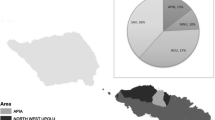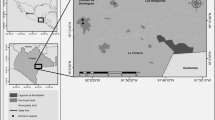Abstract
Parrots are one of the most threatened bird species in the world, partly due to the illegal parrot trade. Previous research has attempted to explain why some parrot species are more likely to be poached for illicit markets, though these studies suffer from a small sample size or focus on a singular illicit market. Whether these past findings are generalizable to other markets in other countries remains unknown. Using two recent conservation studies that examine illicit pet markets in seven cities within Peru and Bolivia (Gastanaga et al., Bird Conservational International, 1–10, 2010; Herrera and Hennessey, Tundra to Tropics, 232–234, 2008), this study applies the CRAVED model (Clarke, London: Home Office, 1999) to identify which factors are able to explain poaching variation of species. Findings show that the more concealable, available, abundant, and disposable species are poached more often. Enjoyable, removable, and valuable species were not found to be significantly related with poaching. Implications of these findings are discussed.

Similar content being viewed by others
Notes
“Market” in this paper is used to describe open-air markets where parrots are generally sold in the neo-tropics.
The 80-20 rule is a phenomenon in which a small proportion of something (i.e., number of species) represents a large proportion of an outcome (i.e., total parrots poached).
Data for Peruvian markets and the Bolivian market could not be combined because of different data collection methods. Therefore, data from the Bolivian market was dropped from this analysis.
Price data is missing for 21 out of 52 species located around Peruvian markets and ten out of 35 Bolivian species.
Ranges of species do change over time, especially when threatened by the illegal trade and habitat loss. Other times, they get bigger because they quickly become over-populated.
It has been made aware to the author that at least one parrot range shapefile is not completely accurate. The shapefile of the Blue-fronted Parrotlet (Touit dilectissimus) suggests its closest point to the city of Santa Cruz is 103 miles away, when in reality, it has a range over the city (Pires and Clarke 2011).
In previous decades, crop pests were more likely to be shot by farmers. Without reducing the provocations that some species cause to farmers, eliminating mist nets might have the unintended consequences of bringing this tradition back. Thus, allowing a well-regulated capture quota system of crop pest species might be the best solution.
References
(IUCN) International Union for Conservation of Nature (2011). Red List of Threatened Species. http://www.iucn.org/about/work/programmes/species/red_list/. Date accessed 1 Sept 2011.
Armstrong, M. C., Farinato, R. H., & Telecky, T. M. (2001). A wing and a prayer: birds and their protection under law. Journal of Avian Medicine and Surgery, 15(4), 310–315.
Baker, S. (2003). An analysis of timber trespass and theft issues in the southern Appalachian Region. Masters in Science in Forestry. Blacksburg, VA: Virginia Polytechnic Institute.
Cantu, J. C. G., Saldana, M. E. S., Grosselet, M., & Gamez, J. S. (2007). The illegal parrot trade in Mexico: A comprehensive assessment. Mexico and Washington, DC: Defenders of Wildlife.
Clarke, R. V. (1999). Hot Products: Understanding, Anticipating and Reducing Demand for Stolen Goods. Police Research Series, Paper 112. Policing and Reducing Crime Unit, Research Development and Statistics Directorate. London: Home Office.
Clarke, R. V., & Eck, J. E. (2005). Crime analysis for problem solvers. In 60 small steps. Office of Community Oriented Policing Services. Washington, DC: US Department of Justice.
Cohen, L. E., & Felson, M. (1979). Social change and crime rate trends: a routine activity approach. American Sociological Review, 44, 588–605.
Drews, C. (2001). Wild animals and other pets kept in Costa Rican households: incidence, species and numbers. Society and Animals, 9, 107–126.
Fass, S. M. & Francis, J. (2004). Where have all the hot goods gone? The role of pawnshops. Journal of Research in Crime and Delinquency, 41, 156–179.
Gastanaga, M., Macleod, R., Hennessey, B., Nunez, J. U., Puse, E., Arrascue, A., Hoyos, J., Chambi, W. M., Vasquez, J., & Engblom, G. (2010). A study of the parrot trade in Peru and the potential importance of internal trade for threatened species. Bird Conservational International, 21(1), 76–85.
Gonzàlez, J. A. (2003). Harvesting, local trade, and conservation of parrots on the Northeastern Peruvian Amazon. Biological Conservation, 114, 437–446.
Guerette, R. T., & Bowers, K. J. (2009). Assessing the extent of crime displacement and diffusion of benefits: a review of situational crime prevention evaluations. Criminology, 47(4), 1331–1368.
Hennessey, B., Herzog, S. K., & Sagot, F. (2003). Lista Anotada de las Aves de Bolivia. Santa Cruz: Asociacion Armonia/Birdlife International.
Herrera, M., & Hennessey, B. (2007). Quantifying the illegal parrot trade in Santa Cruz de la Sierra, Bolivia, with emphasis on threatened species. Bird Conservation International, 17, 295–300.
Herrera, M., & Hennessey, B. (2008). Monitoring results of the illegal parrot trade in the Los Pozos Market, Santa Cruz De La Sierra, Bolivia. Proceedings of the Fourth International Partners in Flight Conference: Tundra to Tropics, 232–234.
Howell, S. N. G., & Webb, S. (1995). A guide to the birds of Mexico and Northern Central America. New York: Oxford University Press.
Juniper, T., & Parr, M. (1998). Parrots: A guide to parrots of the world. New Haven: Yale University Press.
Natarajan, M. (2012). A rational choice analysis of organized crime and trafficked goods. In N. Tilley & G. Farrell (Eds.), The Reasoning Criminologist: Essays in Honour of Ronald V. Clarke. New York: Routledge.
Pain, D. J., Martins, T. L. F., Boussekey, M., Diaz, S. H., Downs, C. T., Ekstrom, J. M. M., Garnett, S. T., Gilardi, J. D., McNiven, D., Primot, P., Rouys, S., Saoumoé, M., Symes, C. T., Tamungang, S. A., Theuerkauf, J., Villafuerte, D., Verfailles, L., Widmann, P., & Widmann, I. D. (2006). Impact of protection on nest take and nesting success of parrots in Africa, Asia, and Australia. Animal Conservation, 9, 322–330.
Petrossian, G. A., & Clarke, R. V. (2014). Explaining and controlling illegal commercial fishing an application of the CRAVED theft model. British Journal of Criminology, 54/1, 73–90.
Pires, S. F. (2014). The heterogeneity of illicit parrot markets: an analysis of 7 neo-tropical open-air markets. European Journal on Criminal Policy and Research. doi:10.1007/s10610-014-9246-6
Pires, S. F., & Clarke, R. V. (2011). Sequential foraging, itinerant fences and parrot poaching in Bolivia. British Journal of Criminology, 51, 314–335.
Pires, S., & Clarke, R. V. (2012). Are parrots CRAVED? An analysis of parrot poaching in Mexico. Journal of Research in Crime and Delinquency, 49, 122–146.
Pires, S. F., & Moreto, W. D. (2011). Preventing wildlife crimes: solutions that can overcome the ‘tragedy of the commons’. European Journal on Criminal Policy and Research, 17, 101–123.
Pires, S., & Guerette, R. (2014). Does opportunity make the poacher? An analysis of neo –tropical illicit parrot markets. In A. M. Lemieux (Ed.), Situational prevention of poaching. London: Routledge.
Schulenberg, T. S., Stotz, D. F., Lane, D. F., O'Neill, J. P., & Parker, T. A., III. (2007). Birds of Peru. Princeton: Princeton University Press.
Sidebottom, A. (2013). On the application of CRAVED to livestock theft in Malawi. International Journal of Comparative and Applied Criminal Justice, 37(3), 195–212.
Smith, B. T., & Clarke, R. V. (2014). Shoplifting of everyday products that serve illicit drug uses. Journal of Research in Crime and Delinquency. doi:10.1177/0022427814549469.
Smith, C., Bowers, K. J., & Johnson, S. D. (2006). Understanding bag theft within licensed premises in Westminster: identifying initial steps towards prevention. Security Journal, 19:3–21.
Socioeconomic Data and Applications Center (SEDAC). (2010). Species distribution grid. Available online at http://sedac.ciesin.columbia.edu/species/about.jsp. Accessed 1 Sept 2010.
Tella, J. L., & Hiraldo, F. (2014). Illegal and legal parrot trade shows a long-term, cross-cultural preference for the most attractive species increasing their risk of extinction. PLoS One 16;9(9):e107546. doi: 10.1371/journal.pone.0107546
Wellsmith, M., & Burrell, A. (2005). The influence of purchase price and ownership levels on theft targets. British Journal of Criminology, 45, 741–764.
Whitehead, S., Mailley, J., Storer, I., McCardle, J., Torrens, G., & Farrell, G. (2008). In safe hands: a review of mobile phone anti-theft designs. European Journal on Criminal Policy and Research, 14, 39–60.
Wright, T., Toft, C. A., Enkerlin-Hoeflich, E., Gonzalez-Elizondo, J., Albornoz, M., Rodriguez-Ferraro, A., Rojas-Suarez, F., Sanz, V., Trujillo, A., Beissinger, S. R., Berovides, A. V., Galvez, A. X., Brice, A. T., Joyner, K., Eberhard, J., Gilardi, J., Koenig, S. E., Stoleson, S., Martuscelli, P., Meyers, J. M., Renton, K., Rodriguez, A. M., Sosa-Asanza, A. C., Vilella, F. J., & Wiley, J. W. (2001). Nest poaching in neotropical parrots. Conservation Biology, 15, 710–720.
Acknowledgments
I’d like to thank Dr. Ron Clarke for giving me invaluable advice on this research paper as well as mentoring me throughout my graduate career at Rutgers University. I would also like to thank Dr. Jackie Schneider and the reviewers for giving me helpful feedback on improving this paper.
Author information
Authors and Affiliations
Corresponding author
Appendix
Appendix
Rights and permissions
About this article
Cite this article
Pires, S.F. A CRAVED Analysis of Multiple Illicit Parrot Markets in Peru and Bolivia. Eur J Crim Policy Res 21, 321–336 (2015). https://doi.org/10.1007/s10610-014-9264-4
Published:
Issue Date:
DOI: https://doi.org/10.1007/s10610-014-9264-4




